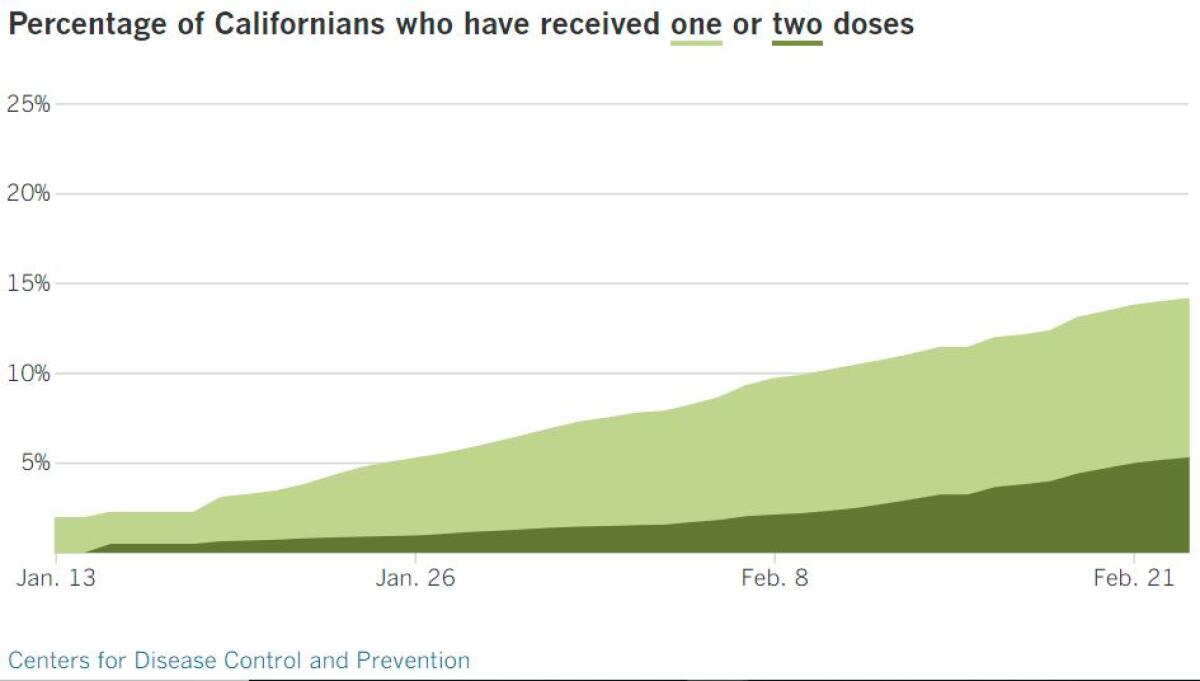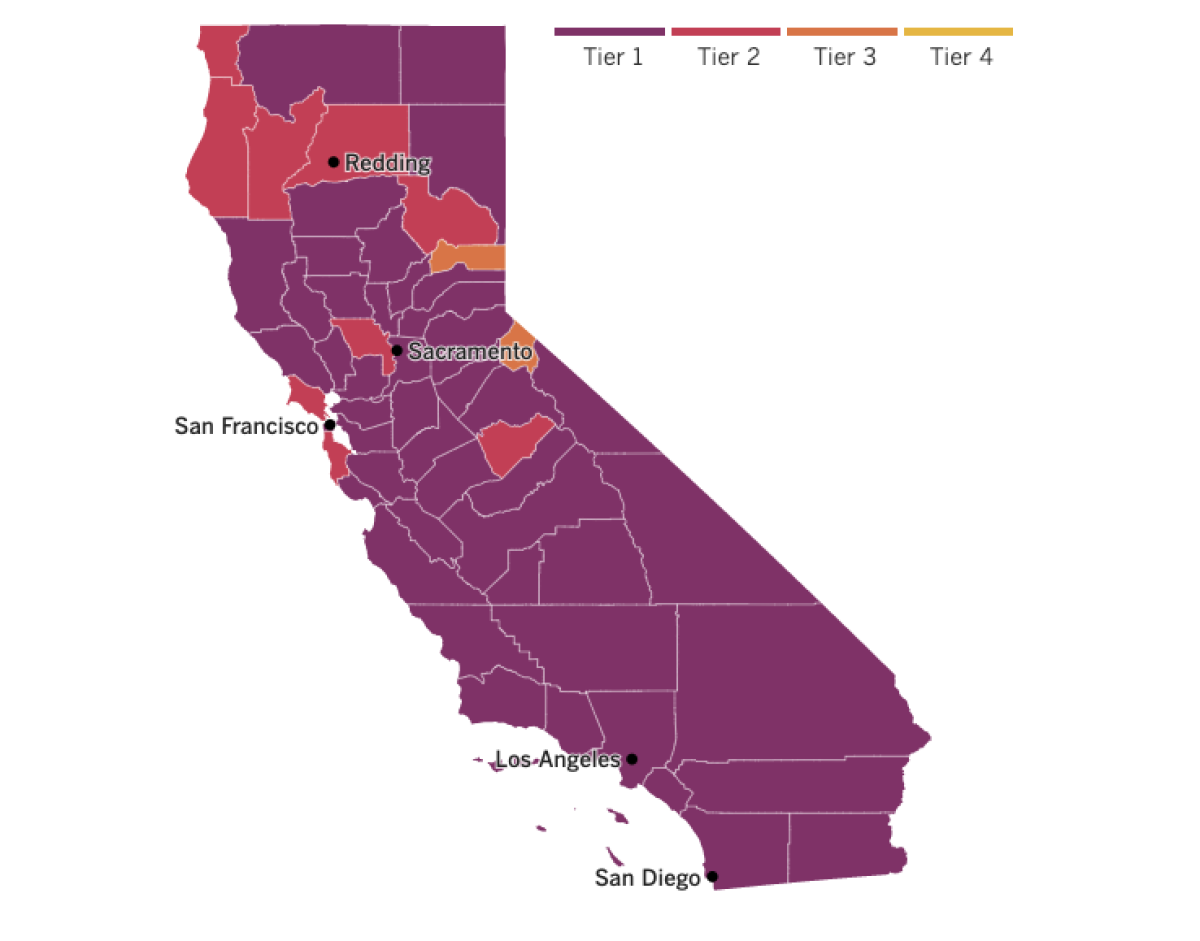Coronavirus Today: Our homegrown triple threat
Good evening. I’m Thuc Nhi Nguyen, and it’s Tuesday, Feb. 23. Here’s what’s happening with the coronavirus in California and beyond.
Coronavirus variants aren’t just an international problem anymore.
Scientists at UC San Francisco are ready to tag California’s homegrown coronavirus strain as a “variant of concern,” putting it in the company of those from the United Kingdom, South Africa and Brazil. The state’s dominant strain packs a triple-threat punch: It can spread more easily than its predecessors, it shows some resistance to antibodies generated by COVID-19 vaccines or prior infection, and it’s associated with severe illness and death, my colleague Melissa Healy reports.
“The devil is already here,” said Dr. Charles Chiu, who led the UCSF team of geneticists, epidemiologists, statisticians and other scientists in a wide-ranging analysis of the new variant. “I wish it were different. But the science is the science.”
They call the new variant B.1.427/B.1.429. It will likely account for 90% of California’s infections by the end of the month, Chiu said.
Since Sept. 1, the California strain has risen from complete obscurity to account for more than 50% of all coronavirus samples that were subjected to genetic analysis in the state. It has shown an enhanced ability to spread compared to strains that were prominent here in early fall — but just how much more contagious it is remains to be seen.
One of the reasons why scientists believe the California strain is more contagious is a mutation that helps the virus attach more firmly to the human cells it targets. It is one of three mutations in the homegrown variant’s genome that affect the spike protein, which the virus uses to sneak into human cells and convert them into factories for its own production.
The scientists found that B.1.427/B.1.429 was more resistant to the neutralizing antibodies that are generated in response to COVID-19 vaccines or to a coronavirus infection, cutting their effectiveness in half. That’s not on the same level as the South African variant, which reduced the effectiveness of neutralizing antibodies to one-sixth their usual levels. But it’s still enough for Chiu to fret that it could blunt the effects of vaccines over time.
As if that weren’t enough motivation to keep sticking with public health strategies to slow the spread of the coronavirus, the scientists also found that the California variant was associated with worse health outcomes. Examining a relatively small sample of 324 patients hospitalized at UCSF, researchers found that 21% of these patients were infected with the California strain, and compared to patients battling other strains, they were more likely to have been admitted to the ICU and 11 times more likely to die of COVID-19.
Chiu said the increased risk of death doesn’t necessarily mean the California strain is more lethal. It could reflect the fact that greater virus transmissibility caused hospitals to become overwhelmed with COVID-19 patients, and the higher death rate may have been due to healthcare resources being stretched too thin. Experts are already analyzing the extent to which the surge in Southern California may have impacted health care.
UCSF’s analysis is currently under review by the public health departments of San Francisco County and the state, which collaborated in the new research.
By the numbers
California cases, deaths and vaccinations as of 5:53 p.m. Tuesday:

Track California’s coronavirus spread and vaccination efforts — including the latest numbers and how they break down — with our graphics.

Across California
The pandemic has disproportionately affected communities of color, and health officials have responded by bolstering their efforts to get COVID-19 vaccines to underserved people. Today, my colleague Julia Wick reports on one such effort that seems to have backfired — and on the state’s move in response to make changes to that program. For more from her on the story, read her Essential California newsletter from today, and sign up to get it if you don’t.
Her story centers on a program launched by the state to reserve appointments for Black and Latino Californians. It was supposed give special access codes to community organizations that would distribute them to people in the underserved communities who are vaccine eligible, including healthcare workers and those older than 65. When entered into the My Turn vaccine scheduling website, the codes unlock a specific block of appointments at the federally run Cal State L.A. and Oakland Coliseum vaccination sites.
The system was supposed to make it easier for people who might otherwise struggle to get an appointment. Instead, the codes have ended up in the hands of the wealthier, work-from-home set in Los Angeles. Many of these recipients are not yet eligible for the vaccine, but were able to get their shots anyway.
How this happened remains unclear. Some people received access through forwarded messages from friends in group chats on social media. They thought it was a pilot program for a new testing site, and that the appointment times were “leftovers” open to everyone.
In response, Gov. Gavin Newsom said Tuesday that the state would be “moving away” from the group code system, though he didn’t provide details about what changes would be made to the program. “We don’t like to see those abuses,” he said.
For those who were supposed to have gotten the codes, it was another source of frustration. “People are getting greedy and butting in line, coming to be first in line and pushing out those who are dying and in most need,” said Dr. Don Garcia, medical director at Clínica Romero, which serves Spanish-speaking Latino and Indigenous people from Mexico and Central America in Boyle Heights and Pico-Union.
Alas, that is just another pitfall in a growing list of problems with the state’s vaccine program. Among them: A communication breakdown between state and local officials has kept many vaccination sites from running smoothly, my colleagues Laura J. Nelson and Maya Lau report.
Every Tuesday morning, Gov. Gavin Newsom learns how many doses the state will receive over the next three weeks. It’s a critical piece of information needed to keep vaccine sites operating efficiently. But this information doesn’t make its way to many local leaders, who can’t schedule appointments and plan for the administration of second doses.
“Every vaccine planner right now, we all have nerves in our stomach. We’re nervous about it,” said Joe Prado, community health division manager for the Fresno County Department of Public Health. “We would all like to have a three-week window, but until then we will just continue to do it week to week.”
The communication problems have added more roadblocks to a process already plagued by supply issues and inclement weather. But with winter storms thawing in other parts of the country, the city of L.A. was able to resume operations at its large vaccination sites Tuesday. Priority will go to those who had their appointments canceled after delayed shipments forced the sites to close over the weekend.
And here’s some more good news: The number of counties that are no longer in the state’s most restrictive purple tier nearly doubled on Tuesday, to 11. The promotions were concentrated in Northern California, where San Mateo, Marin, Yolo, Shasta and Humboldt counties all moved to the second-most-restrictive red tier. Six sparsely populated counties in the northern part of the state — Alpine, Del Norte, Mariposa, Plumas, Sierra and Trinity — were already outside of the purple tier.
Among the indoor operations allowed in red-tier counties is the resumption of indoor restaurant dining at up to 25% capacity or 100 people, whichever is fewer. Not only is that welcome news for diners, it’s good for restaurants that have been limited to take-out and delivery service for much of the past year.
In addition to the loss of business, some restaurants are also battling a slew of fraudulent charges. It’s a new version of dine and dash, my colleague Jenn Harris reports, as people scam restauranteurs with fraudulent credit cards or refund requests where they claim they never received an order. Scammers are able to take advantage of restaurants that have prioritized safety over in-person security measures, such as checking driver’s licenses and manually swiping credit cards.
Crushed by a series of disputed charges for hundreds of dollars each, Spoon by H, a celebrated Korean restaurant in Fairfax, will close this weekend. “We lost orders, time, precious ingredients, and the problems accumulated to the point where we just couldn’t stay in business anymore,” owner Yoonjin Hwang said. “We’re losing money to these issues, despite all the evidence we provide.”
Businesses hurt in the pandemic could get help from California’s new COVID-19 relief plan, which Newsom signed into law Tuesday. The package sets aside $2.1 billion for small business owners in addition to $600 stimulus checks for low-income Californians.
Small businesses with annual gross revenue of up to $2.5 million are eligible to apply for grants ranging from $5,000 to $25,000, but not every business will be awarded one. The decision process will consider factors like location, whether the business is owned by people of color and whether it is in an industry sector most affected by the pandemic. State officials estimate the approval process will take 45 days. For more on the help available to small businesses, get our Business team’s newsletter.


See the latest on California’s coronavirus closures and reopenings, and the metrics that inform them, with our tracker.
Consider subscribing to the Los Angeles Times
Your support helps us deliver the news that matters most. Become a subscriber.
Around the nation and the world
Last summer, LeBron James took over Walt Disney World as he led the Los Angeles Lakers to the NBA championship. This summer, it will be a group of middle school kids taking center stage at ESPN’s Wide World of Sports campus.
The Scripps National Spelling Bee will return in 2021 with a dozen finalists gathering on the same campus that housed the NBA bubble. Instead of the customary “Bee Week” that brings together competitors from across the country for a whole week of spelling, the bee will span several weeks, with the early rounds taking place virtually. The in-person finals will be televised on ESPN on July 8.
The competition that started in 1925 asks kids up to eighth grade to spell obscure words for which they’ve researched roots, definitions and language patterns. Why would a middle schooler choose such a hobby? The $50,000 prize is a good start, not to mention the opportunity to be on national TV during a prestigious competition. The event wasn’t held last year because of the pandemic, and that was the first time it had been canceled since World War II.
With coronavirus cases dwindling, there’s hope that canceling annual events could soon be a thing of the past — especially with more doses of vaccine on the way.
COVID-19 vaccine makers assured Congress on Tuesday that there will be large deliveries of doses over the next month. By the end of March, Pfizer and Moderna expect to have sent a total of 220 million doses of COVID-19 vaccines to the U.S. government. The delivery would be a sharp increase from the roughly 75 million doses shipped so far.
What’s more, the one-dose COVID-19 vaccine from Johnson & Johnson‘s Janssen Biotech unit could get the green light from regulators soon, and the Biden administration said it expects about 2 million doses of the new shot to be shipping in the first week after it is authorized for emergency use. The company said it could provide enough doses for 20 million people by the end of March.
The combined efforts from the three companies should result in enough vaccines for every American adult by the end of the summer, the companies say. Pfizer and Moderna, whose vaccines each require a two-shot regimen, expect to deliver 300 million doses apiece, while Johnson & Johnson aims to provide an additional 100 million doses.
What will things be like when many more shots are delivered? If the experience of Scotland is any guide, we can look forward to a sharp drop in hospitalizations.
The vaccine developed by AstraZeneca and Oxford University reduced hospital admissions for COVID-19 by up to 94% four weeks after people received their first dose, according to researchers at the University of Edinburgh, the University of Strathclyde and Public Health Scotland. In addition, the Pfizer-BioNTech vaccine cut hospital admissions by up to 85%.
The preliminary findings offer encouraging evidence of the shots’ real-world impact. But independent experts didn’t want to jump to conclusions, particularly because relatively few people overall were hospitalized with COVID-19 after receiving vaccinations during the study period of Dec. 5 to Feb. 15.
Your questions answered
Today’s question comes from readers who want to know: When will I get my California stimulus check?
Relief is on the way. But first, you’ll have to do your taxes.
Californians who qualify for the $600 state stimulus payment could see the money in their bank accounts within a month after filing their tax returns, my colleague Patrick McGreevy reports. To get the fastest results, sign up for direct deposit when you file your 2020 return with the state Franchise Tax Board. If you opt for a check, you could find yourself waiting for up to seven weeks.
A majority of these stimulus payments, which are part of the new COVID-19 relief plan, will go to households that qualified for the state earned income tax credit for 2020, which is available to residents who make less than $30,000 a year. Others who qualify include:
- People with individual tax identification numbers who did not receive federal stimulus payments and whose income is below $75,000. Californians in this group who make less than $30,000 a year would receive $1,200 from the state.
- People who are part of the state’s welfare-to-work CalWORKS program. CalWORKS payments will be placed on EBT cards and issued by mid-April.
- People who receive money from the federal supplemental security income or state supplementary payment programs. The timing and method of grant payments for people in this category is not yet confirmed, and will depend on input from the federal Social Security Administration.
- People who are part of the Cash Assistance Program for Immigrants.
In total, state officials anticipate sending 5.7 million stimulus payments adding up to $2.3 billion.
We want to hear from you. Email us your coronavirus questions, and we’ll do our best to answer them. Wondering if your question’s already been answered? Check out our archive here.
Resources
Need a vaccine? Keep in mind that supplies are limited, and getting one can be a challenge. Sign up for email updates, check your eligibility and, if you’re eligible, make an appointment where you live: City of Los Angeles | Los Angeles County | Kern County | Orange County | Riverside County | San Bernardino County | San Diego County | San Luis Obispo County | Santa Barbara County | Ventura County
Practice social distancing using these tips, and wear a mask or two.
Watch for symptoms such as fever, cough, shortness of breath, chills, shaking with chills, muscle pain, headache, sore throat and loss of taste or smell. Here’s what to look for and when.
Need to get tested? Here’s where you can in L.A. County and around California.
Americans are hurting in many ways. We have advice for helping kids cope, resources for people experiencing domestic abuse and a newsletter to help you make ends meet.
We’ve answered hundreds of readers’ questions. Explore them in our archive here.
For our most up-to-date coverage, visit our homepage and our Health section, get our breaking news alerts, and follow us on Twitter and Instagram.




